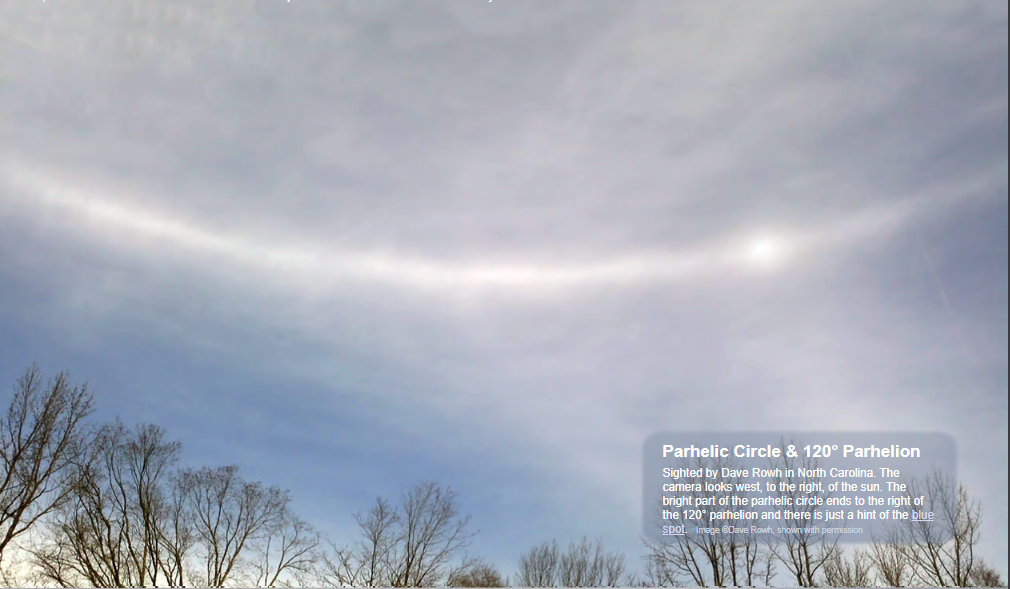XXXX - OPOD
Parhelic Circle & 120° Parhelion
When it comes to atmospheric optics, one phenomenon that captivates observers is the parhelic circle and the 120° parhelion. These intriguing optical effects can be witnessed under specific conditions and are a delight for sky enthusiasts. While the 22° parhelion or sundog displays an array of colors, the 120° parhelion appears colorless in comparison. This is because the 120° parhelion requires thick or triangular aspect plates, making it less common to observe. Additionally, it tends to blend in with white clouds, making it less conspicuous.
The formation of the 120° parhelion involves hexagonal plate crystals, similar to the process behind the 22° parhelion. In this case, a ray of light enters through the top face of the crystal, undergoes two internal reflections from the vertical side faces, and finally exits through the lower hexagonal face. Importantly, the entrance and exit angles of the light are equal, causing the two color dispersions to cancel each other out. As a result, the 120° parhelion lacks the vibrant hues seen in its 22° counterpart.
While observing the parhelic circle, one may notice a fading effect beyond the 120° parhelion. This fading occurs due to the transition from partial to total internal reflection of sunlight inside ice crystals. As internal rays become less steeply inclined to a surface, there is a sudden change where all the light is reflected. This phenomenon is also utilized in prism binoculars to achieve near-perfect reflection by the erecting prisms.
Understanding these atmospheric optical phenomena provides a deeper appreciation for the complexity and beauty of our atmosphere. By observing these unique events, we gain insight into the intricate interactions between light and ice crystals in our atmosphere. So, next time you find yourself gazing at the sky, keep an eye out for the parhelic circle and the elusive 120° parhelion. Their presence adds an extra touch of wonder to our daily encounters with nature.
Remember, this article has been automatically converted from the old site and may not appear as intended. To access the original article, please follow the link provided.

Parhelic Circle & 120° Parhelion
Sighted by Dave Rowh in North Carolina. The camera looks west, to the right, of the sun. The bright part of the parhelic circle ends to the right of the 120° parhelion and there is just a hint of the blue spot. Image ©Dave Rowh, shown with permission

In contrast to the colourful 22° parhelion or sundog, the 120° parhelion is colourless.
It needs thick or triangular aspect plates and is thus seen less often. It is also stands out less from white clouds.
Like the 22° parhelion, it is formed by hexagonal plate crystals. One ray path is through the top face, two internal reflections from vertical side faces and exit through the lower hexagonal face.
The entrance and exit angles are equal and so the two colour dispersions cancel out.
Fading parhelic circles
The parhelic circle fades noticeably past the 120° parhelion.
The change is caused by transition from partial to total internal reflection of sun rays inside ice crystals.
Internal rays steeply inclined to a surface partially escape and are partially internally reflected. As the angle becomes less steep there is a sudden change and all the light is reflected.
Prism binoculars rely on this for near perfect reflection by the erecting prisms.
Note: this article has been automatically converted from the old site and may not appear as intended. You can find the original article here.
Reference Atmospheric Optics
If you use any of the definitions, information, or data presented on Atmospheric Optics, please copy the link or reference below to properly credit us as the reference source. Thank you!
-
<a href="https://atoptics.co.uk/blog/xxxx-opod/">XXXX - OPOD</a>
-
"XXXX - OPOD". Atmospheric Optics. Accessed on November 26, 2024. https://atoptics.co.uk/blog/xxxx-opod/.
-
"XXXX - OPOD". Atmospheric Optics, https://atoptics.co.uk/blog/xxxx-opod/. Accessed 26 November, 2024
-
XXXX - OPOD. Atmospheric Optics. Retrieved from https://atoptics.co.uk/blog/xxxx-opod/.